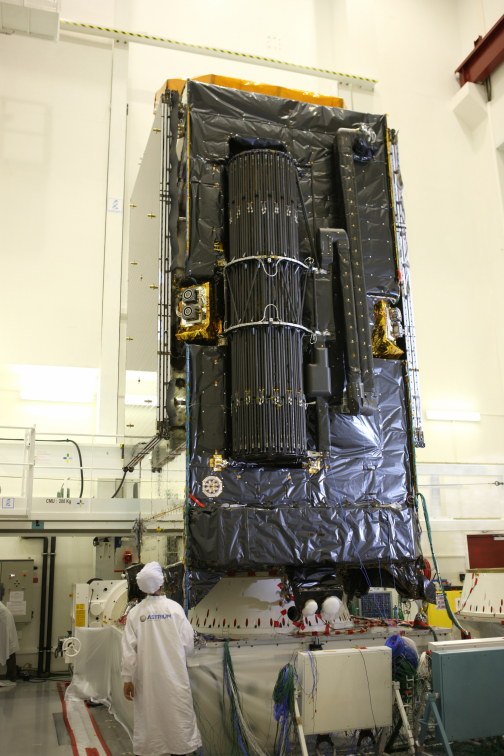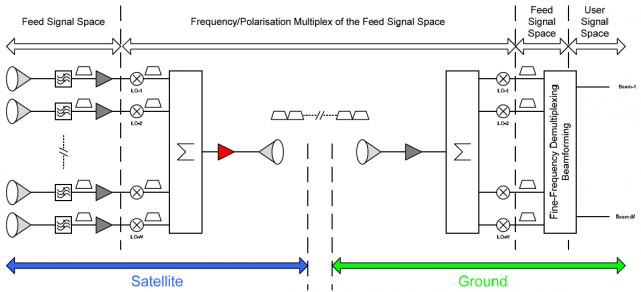-
StatusCompleted
-
Status date2016-02-17
-
Activity Code5A.011
The objective of this activity is to evaluate the potential benefit of OGB compared to OBB in terms of complexity, power, cost and performances for missions with a high number of spot beams like Mobile Satellite Systems.
- The particular requirements and challenges for both OGB and OBB techniques are analysed and compared for several mission and system scenarios. Particular focus is put on the definition and analysis of OGB system through the assessment of its applicability to mission scenarios derived from satellite operator needs.
- The selected solutions are the basis for the definition of a technology roadmap for the European industries.
The study includes also additional tasks in liaison with an Artes 5.1 study on Ground beamforming proof of concept test bed. The objective of these additional tasks is to evaluate the test bed results, and to elaborate on its performance through simulation of a complete satellite system employing OGB fixed beamforming approach.

Some assets of on-ground beamforming techniques have been highlighted by new existing systems in particular dynamic and adaptive ground-based beamforming as well as interference suppression capabilities (adaptation and real time pattern control).
On the other hand a larger feeder link bandwidth is needed and additional calibrations functions are to be implemented.
Moving the beamforming processing from the payload to the ground imply some savings at payload level but it has to be balanced by the additional on-board calibration requirements, improved payload phase noise and stability performances.
It is thus of particular importance to evaluate the potential benefit of On-Ground Beamforming compared to on-board beamforming in terms of complexity/mass/power and cost for Mobile Satellite Systems missions.
Two alternative approaches were followed in the development of recent multispot mobile satellite systems:
- On the one hand systems like Inmarsat 4, Alphasat XL or Thuraya satellites are based on on-board beamforming and channel routing techniques
- On the other hand new hybrid mobile satellite systems like ICO, Terrestar and MSV are based on on-ground beamforming techniques.
The feasibility of the OGB concept has been shown by those systems but no alternative solution is available in Europe at the moment.
It is of particular interest within the frame of this study to evaluate the benefits of on-ground beamforming compared to on-board beamforming. Analysing these benefits will determine the technology roadmap required to maintain assets of the European industries in the MSS domain.
The main features of the “On-Ground Beamforming Techniques” project are:
- To review the OGB/OBB techniques in order to identify suitable techniques and solutions.
- To review the current and foreseen OGB/OBB systems and technologies. It would provide examples of systems implementing OGB highlighting potential issues and/or potential relevant solutions and technologies.
- To interview some mobile satellite operators to define mission scenarios where OGB systems would be appropriate.
- To derive the system scenarios from the mission scenarios. It would provide a framework for the assessment of the different solutions, i.e. OGB and OBB solutions.
- To analyse and trade-off the functionality distribution between the ground segment and the space segment. From this analysis, an architecture and preliminary design of the system for the different solutions (study cases) would be performed.
- To assess the performances of the selected scenarios through software simulations.
- To identify for each considered system scenarios the best suited solution(s).
- To define a roadmap for the ground segment and space segment technologies which shall be developed to implement the selected system solutions for the considered mission scenarios.
system architecture
Following the interview with operators, two scenarios have been retained :
- one mission scenario at L-band with global coverage and similar target performances than Inmarsat-XL satellites and addressing mainly bidirectional mobile applications
- one mission scenario at S-band based on a regional coverage (EU27) with 11 linguistic beams on the FWD and 44 spot beams on the return direction and addressing both mobile broadcasting towards mobile terminals (through the FWD linguistic beam coverage) and bidirectional mobile application
Then a functional architecture and high level design of the system have been defined based on the two reference mission scenarios and two system design approaches (OGB and OBB). Five architectures have been identified, including a partial mission limited to 7MHz (using extended L-band allocation).
Analysis of calibration techniques, beam forming impairments and advanced signal processing allowed the trade-off of on-board and on-ground functionalities.
Various beamforming techniques have been investigated and simulated: fixed, adaptative LCMV and beamspace methods. The benchmarking of ground calibration was performed using spread spectrum techniques through simulations taking into account modelling of ground equipments impairments, propagation channel impairments and payload impairments.

The work is sequenced in five tasks:
- Survey of OGB/OBB techniques and technologies
- State-of-the-art
- Review of current systems
- Definition of reference mission scenarios
- Interview of Satellite Operators
- Mission Definition
- System Requirement Definition
- Evaluation Criteria Definition
- Space/Ground Architectures Trade-offs
- On-Ground Signal Processing
- Beamforming Calibration
- Preliminary Design Definition
- Beamforming Impairments Analysis
- Feeder Link Bandwidth Reduction
- System Performance Assessment
- System Design Consolidation
- Software Development and Validation
- Performance Assessment and Analysis
- Technology Roadmap and Recommendations
- Ground Technology Roadmap
- Space Technology Roadmap
The study, including the CCN activities, is now completed with the following achievements :
- Survey of the literature and patents dealing with OGB architecture and investigation of the current systems implementing OGB (TDRSS, ICO G1, Terrestar, Skyterra)
- Selection of two scenarios of main interest for the task of mission definition:
- Architecture trade-offs .
- S and L-band missions’ consolidation and performances assessment through software tool simulations.
- Key technological developments roadmap to ensure European industry competitiveness in the strategic field of MSS
- Analysis of the results of a test bed (carried out in the frame of another Artes 5.1 Study)



